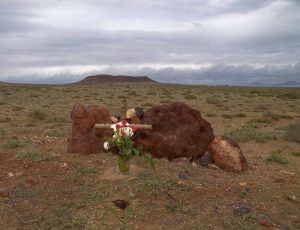Tree monuments make visible the unexpected and violent strike of death. Usually along public roads but sometimes in more remote places. Amersfoort-based photographer Jeroen Hansen photographed hundreds of them in recent years, resulting in the recently published photo book Signs of Life.
A bunch of flowers tied to a dented crash barrier. Candles, photos or a teddy bear at a sharp bend. Two crosses at the edge of a steep ravine. We drive or walk past them, maybe wonder for a moment what happened and get on with our existence.
Photographer Jeroen Hansen: ,,While on holiday in Lanzarote, I saw a cross, a flower and a pile of stones in the middle of the rugged deserted landscape. I thought it was a mystical place. I took a photo. Later on the holiday, I came across another such place of remembrance. I photographed that one too. When I got home I looked at the photos and immediately knew: I have to do something with this."

Photo: Jeroen Hansen
Hansen jumped in his car and drove criss-cross the Netherlands the following years to photograph roadside monuments everywhere. ,,I was really captivated by them. Some monuments I visited very often, until the right moment came to capture them. The right light, the right atmosphere. With two crosses and a small cross near Dokkum, doubt suddenly struck me. Am I doing the right thing here? Am I not a voyeur? Am I not exploiting the suffering of others? I then looked up what had happened there on the Internet. I contacted the relatives and spoke to them at length. It turned out that they had lost two daughters and an unborn child. Then my doubts were gone. It was so awe-inspiring what had happened. Through my photographs, their story had to be told."
Later, Hansen also travelled extensively abroad. He saw the differences. ,,In Germany you have many more chapels. In southern European countries you often have crosses or crucifixes. There, the monuments sometimes have something heroic, something macho. For example, when a motorcyclist crashed because he was speeding. The cultural differences, the landscape and the weather became more important for my photographs."
Intense
Leafing through Signs of Life is an intense but not easy experience. Hansen and his publisher Gerard Keijsers chose not to add any information to the photos. The image has to tell the story. Moreover, it is a photo book, not a journalistic product," says Keijsers. As a result, with every photo the viewer wonders what could have happened. This causes numbness at a certain point. Another memorial stone. Another sea of flowers around a tree. It is therefore advisable to put the photo book away from time to time, in order to be able to look at it again with an open mind.
Occasional photographs give hints of the tragedy that took place and it is these images that make the most impression and linger.

Moment of peace
Added to ´Signs of Life´ is an essay by Mirjam Klaassens. She investigated funeral monuments as a social phenomenon. According to Klaassens, funeral monuments are part of the development in the Western world that death is no longer a taboo, exclusively reserved for the private sphere, but is increasingly coming out into the open.
To relatives, she asked why they had placed a monument? Almost always - not surprisingly - it was to keep the memory of the departed alive. To leave a visible trace of his or her existence. Some next-of-kin also wanted to warn others, for example of a dangerous bend or a bad stretch of road, but this was never the primary reason, at most a positive additional rational effect.
The younger the victim, the more likely a berm memorial. "Where society is getting better at controlling death," Klaassens writes, "there is apparently at the same time an increasing need to give a face to precisely those moments when death strikes unexpectedly (at a young age - ed.) and violently."
In her essay, Klaassens distinguishes between spontaneous and long-term roadside memorials. The former are erected soon after the accident by friends and classmates. Over time, these fleeting reminders disappear (tarnished by vandalism or weather, removed by official bodies). Sometimes they make way for permanent monuments. Parents are practically always responsible for this. They contain much more personal information: whereas the spontaneous monuments mainly make it clear that a horrible incident has taken place, the permanent memorials form a personal "place of remembrance" of the deceased.
Over time, berm monuments become less frequent. But removing them is difficult, as it would mean permanently severing contact with the deceased.

Hopeful
Photographer Jeroen Hansen deliberately titled his book Signs of Life. He wanted to indicate that his photos do not so much portray death, but rather tell something about abruptly ended lives and the attempts to give the loss a place. The title has something hopeful, just like the idea that the next-of-kin can still have some kind of contact with the deceased at the memorial on the bier.
Signs of Life creates a wistful feeling about all the misery behind the photographs. But with the photobook, Hansen has also created a photographic monument to the berm and in this way created beauty.
Text: Onno Weggemans
Signs of Life. ISBN: 9789490217600. 140 pag. Hardcover. English-language. € 29,95
